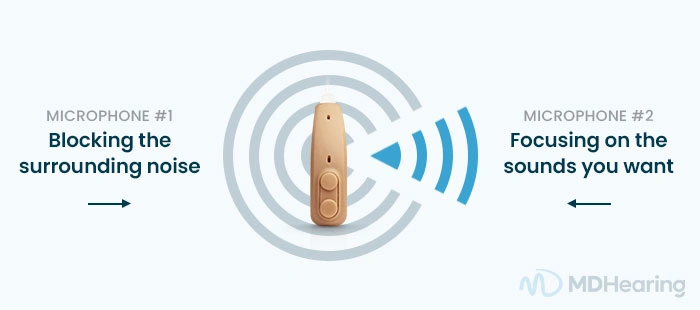Hearing aids have come a long way from the bulky, simplistic devices of the past. Today’s hearing aids are marvels of innovation, incorporating cutting-edge technology that not only improves hearing but enhances the user’s overall experience.
One of the most advantageous advancements is the use of directional microphones, which pick up sound waves from a specific direction rather than all directions. These specialized microphones improve speech clarity by focusing on sounds typically in front of the user, while reducing background noise.
In this article, we will explain the purposes served by both omnidirectional and directional microphones, and why you may want to invest in a hearing aid with a directional microphone—especially if you want to hear what people are saying in noisy environments.
What Are Omnidirectional Microphones?
Every hearing aid features an omnidirectional microphone—which picks up sound equally from all directions, regardless of whether it’s from the front, behind, or the sides. This is fine if you’re in a relatively quiet setting where background sound is minimal and doesn’t need to be filtered out. But in a noisy place like a restaurant, it can be a problem.
-
Benefits of omnidirectional microphones: Omnidirectional microphones are valuable if you want an inexpensive solution for basic listening at home, when there isn’t a lot of noise or background sounds.
-
Challenges of omnidirectional microphones: If you want to socialize in more complex listening situations—such as parties, restaurants, church, or meetings—an omnidirectional microphone will only make listening more difficult. We can’t stress this enough: A hearing aid with a directional microphone is essential for noisy places.
What Are Directional Microphones?
Some hearing aids include both omnidirectional and directional microphones. Directional microphones consist of two or more microphones placed in different locations on the hearing aid. They use this “directionality” to identify and process multiple sound signals, amplifying sounds coming from the front while filtering out noise from other directions. This makes directional microphones ideal for noisy environments, where the goal is to prioritize the sounds that are most relevant—like speech—while minimizing distractions.
More advanced hearing aids also have “adaptive directional microphones”, which can change their focus to zero in on the most important sounds in the room and automatically adjust to the level of background noise. For example, this would enable your hearing aid to focus on the conversation with your dinner date. However, when a server approaches, the hearing aid will recognize a new, nearby speech signal, and widen the listening area to hear the server as well, without needing to turn your head (more on this below).
-
Benefits of directional microphones: Directional microphones help you achieve the clearest listening in any environment, whether it be a noisy restaurant, meeting, or social gathering.
- Challenges of directional microphones: Hearing aids with directional microphones may have a higher price tag due to the more advanced technology. In addition, this sophisticated technology can sometimes lead to quicker battery drain compared to simpler hearing aids.
“The Cocktail Party Effect”: Omnidirectional Microphones vs. Directional Microphones
The “cocktail party effect” refers to your brain’s ability to focus on specific voices among various other voices. This is how you can hear your name being mentioned in a conversation on the other side of a room, or how you can focus on your conversation over many others around you. Your brain can isolate and focus on certain sounds.
Unfortunately, your “cocktail party” listening abilities are the first to go when you have hearing loss. Listening in a noisy environment becomes increasingly difficult because your brain isn’t receiving the same clarity of sound information.
Here’s how omnidirectional and directional microphones affect your listening abilities:
-
Omnidirectional microphones: In certain circumstances, omnidirectional mics could make listening in noisy environments like restaurants harder or more frustrating because they pick up and amplify all sounds equally. Nevertheless, having an omnidirectional-only hearing aid is usually better than having nothing at all.
-
Directional microphones: Directional microphones won’t restore all your “cocktail party” listening abilities, but they will restore some in surprising and incredible ways. The directionality of the microphone helps you discern the voices of people near you, which is a tremendous gift if you struggle with hearing loss.
Types of Directional Microphone Technology
Now that you understand the “why” of directional microphones, let’s explore the different types of directional microphone technology:
-
Fixed: Fixed directional microphones are often paired with omnidirectional microphones and must be manually activated to a directional mode (using a button, remote, or app). In the directional mode, the microphones pick up sound predominantly from one direction, typically in front of you. These microphones don’t adjust based on the environment; they simply amplify sound from a particular direction while reducing sound from other directions. This basic directional microphone feature can radically improve the performance of a hearing aid in a noisy room and is most effective when you are facing a sound source directly.
-
Automatic: Automatic directional microphones monitor the noise levels around you and automatically switch from omnidirectional mode to directional mode when the noise levels become loud enough to overpower speech signals. This process is seamless and allows you to wear the hearing aid in noisy situations without needing to manually turn on the directional microphone.
-
Adaptive: Adaptive directional microphones are more flexible and automatically shift their focus if the sound source moves or the environment changes. This technology continuously adjusts the microphones to provide the best balance between speech and noise, based on real-time analysis. Hearing aids with adaptive directional microphones give you the freedom to move comfortably between dynamic environments.
How do directional microphones work?
Typically, two microphones are positioned a certain distance from each other on the hearing aid. The distance between the microphones causes the same sounds to hit the microphones at different times. This time difference is minuscule, but the sound processor in the hearing aid senses and analyzes it to determine where sounds are coming from. The processor then amplifies the wanted sounds, such as speech or music, and reduces unwanted background noise.
What hearing aids use directional microphones?
Directional microphones are a key feature in many behind-the-ear (BTE) hearing aids. However, they’re not typically found in in-the-ear (ITE) hearing aids. The reason lies in the natural acoustics of the ear: the pinna (or outer ear) already provides directional cues by funneling sounds from specific directions into the ear canal.
As a result, ITE hearing aids do not require the additional technology of directional microphones, relying instead on the natural sound localization provided by the ear's shape and structure.
MDHearing’s Affordable, High-Quality Hearing Aids with Directional Microphones
MDHearing offers two affordable, high-quality digital hearing aids with directional microphones, engineered to improve your listening experience in noisy environments. By focusing on sounds coming from the front and reducing background noise from other directions, these hearing aids make it easier for you to engage in conversations, whether in a crowded restaurant or at a family gathering.
-
MDHearing VOLT: The VOLT includes both an omnidirectional microphone and a fixed directional microphone. This technology distinguishes the sounds you want to hear (such as voices) from the ones you don’t (background noise) to maximize listening clarity in noisy environments. With a simple touch of a button, you can switch between modes that use the omnidirectional microphone or directional microphone.
-
MDHearing VOLT MAX: The VOLT MAX features both an omnidirectional microphone and an adaptive directional microphone as described above. The VOLT MAX analyzes the surrounding sound environment, then automatically adapts the microphone direction for maximum listening clarity. When activated, the adaptive directional microphone focuses on speech, regardless of where it is coming from.
As with all MDHearing products, the VOLT and VOLT MAX are FDA-registered, designed to assist 94% of people with hearing loss, and come with a 100% money-back guarantee. If you’re not fully satisfied with your MDHearing, you can return it for a full refund.
Shop Affordable MDHearing Products Now!
At MDHearing, we keep our costs low by removing the middlemen and selling directly to you without any need for a prescription or an in-office appointment. Simply order your hearing aids online and receive them at your doorstep in a matter of days, fully assembled and ready to use.
We also offer licensed support to ensure you get the best possible experience with your hearing aids. Our team of licensed hearing specialists is available to assist you with any questions, provide advice, and guide you through the fitting and adjustment process. We’re here for you every step of the way.
Learn more about MDHearing’s affordable, high-quality hearing aids.
BROWSE HEARING AIDS


